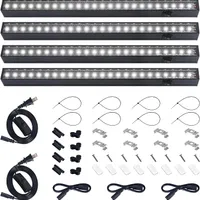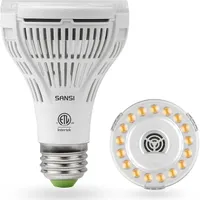The Ultimate Guide to Light for Houseplants
Hello plant lovers, welcome to the world of houseplant light care!
Today, we're diving into one of the most crucial aspects : 🌞 light 🌞.
In this guide, we'll explore everything you need to know about light, from debunking common myths to optimizing light conditions for your indoor jungle. Let's shed some light on the subject! (I'll stop the puns now.)
First, let's address a common misconception: there's no such thing as a "no-light" plant.
Even plants tolerant of low light conditions require some light to survive. Light is essential for photosynthesis, the process by which plants convert light energy into chemical energy to fuel their growth and survival.
Keeping a plant in complete darkness for long periods will lead to weak growth or even death.
Photosynthesis is the plant's method of producing food:
- The plant capture light energy using chlorophyll in its leaves
- This energy is used to convert carbon dioxide and water into glucose (plant food) and oxygen (good for us!)
- The glucose fuels plant growth, while the oxygen is released into the air
Light acts as the catalyst, while water and CO2 are the raw materials. That's it! Simple right?
Understanding plant light needs
Plants have varying light requirements. In Chlorobase, we categorize plants into four main light groups to help you find the ideal location for your green companions.
Low light
All areas of your interior that are in the shade or more than 10 feets away from a natural light source. You can find such lighting ear north-facing windows or in rooms with minimal natural light.
Some plants can survive in low light. However, for optimal growth, provide slightly brighter conditions if possible.
Moderate indirect light
All areas of your interior that are roughly equidistant between shade and sun. These areas benefit from slight brightness throughout the day.
East or west-facing windows are ideal. Alternatively, you can also place it a bit back from a south-facing window.
Bright indirect light
Bright light, usually located near windows but doesn't receive direct rays for more than an hour during the day.
Near south or west-facing windows with a sheer curtain for protection.
Direct sunlight
Light that enters through west or south-facing windows, the most intense light for your interior that will expose plants directly to sunlight.
This type of lighting might be armfull during hot days and summer months. Be carefull not to burn your plant foliage and check on them regularly!
Pro tip to have perfect light conditions
Can't find the perfect spot in your home? Don't worry! You can create your ideal light conditions with sheer curtains to filter bright light, or by using grow lights to boost low-light areas.
Intensity and duration
It's important to consider both light intensity and duration. A plant receiving 4 hours of bright light experiences different conditions than one receiving 12 hours of low light. Both factors play crucial roles in a plant's health and growth patterns.
- Intensity refers to the brightness or strength of the light. It's measured in foot-candles or lux.
- Duration is the length of time a plant is exposed to light each day.
Both factors are important, and sometimes longer exposure to lower intensity light can be as effective as shorter exposure to high intensity light. The key is finding the right balance for each particular plant.
Adapting a plant to new light conditions
When introducing a new plant to your home or relocating an existing one, gradually acclimate it to new light conditions.
This process helps prevent shock and allows the plant to adjust more effectively.
Light impact on watering and fertilizing
The amount of light your plant receives directly affects how much water it needs. In brighter conditions, plants often need more water as they use it up faster through photosynthesis.
In low light, plants use water more slowly, so it's easy to overwater them if you're not careful.
Light also plays a role in fertilization. Plants in bright light may need more frequent feeding because they’re growing faster and using up nutrients more quickly. In contrast, plants in lower light conditions grow more slowly and may need less fertilizer.
So basically: ++ light = +++ water and +++ fertilizer!
Windows and Natural light
Natural light varies depending on window orientation:
- North-facing: Low and indirect consistent light. Suitable for low-light plants.
- South-facing: Brightest light throughout the day. Ideal for plants that love direct sunlight. May require curtains in summer to prevent burns.
- East-facing: Gentle morning sun. Suitable for most moderate to bright indirect light plants.
- West-facing: Strong afternoon sun. Suitable for bright indirect light plants. Similar to south-facing, can also be intense during summer.
To maximize natural light, maintain clean windows and consider using reflective surfaces like mirrors or white walls to distribute light. Window treatments can help manage light intensity: sheer curtains can diffuse harsh light, while fully open blinds allow maximum light penetration.
Seasonal light changes
As seasons change, so does the quality and quantity of light your plants receive. This variation will significantly impact your plants' health and growth patterns.
- 🍂 During fall and winter ❄️, you will need to relocate plants closer to windows or supplement with artificial lighting. Most of your plants grows will slow down or stop to grow altogether. This is totally normal and beneficial for the plant!
- ☀️ In summer, be cautious of intense afternoon sun, which can potentially damage some plants.
For those transitioning outdoor plants indoors for winter, be mindful of the substantial change in light conditions. Gradually acclimate them to indoor environments, and expect some leaf drops as they adjust.
Tropical plants and seasons
Many common houseplants are tropical species that don't experience significant seasonal light changes in their natural habitats. They require extra care during winter months to compensate for reduced light levels.
Troubleshooting
Plants communicate their light needs through various signs:
Signs of excessive light:
- Bleached or yellowing leaves.
- Crispy, brown leaf edges.
- Wilting despite adequate watering.
- Excessive leaf shedding.
Signs of insufficient light:
- Elongated, spindly growth (called etiolation).
- Smaller than normal leaves.
- Loss of variegation in variegated plants.
- Slow or stagnant growth.
Note that these symptoms can sometimes resemble other issues such as improper watering or nutrient deficiencies. Always consider the full spectrum of your plant's care when diagnosing problems.
Artificial lighting solutions
In situations where natural light is limited, artificial lighting can supplement or totally replace natural light. There are many options but you will usually find the following in market.
- LED grow lights: Energy-efficient and available in a range of spectrums to suit different plants.
- Fluorescent lights: Affordable and good for smaller setups, though not as powerful as LED lights.
Tips to find cheap lights
Many lights used for aquariums or terrariums can be perfect for plants! No need to buy a plant-specific device. Just look into your local second-hand groups and apps.
When using artificial lights, aim to mimic natural conditions:
- Position lights 6 inches to 12 inches from plant tops (adjusting based on the light's intensity and the plant's needs).
- Aim for 12-16 hours of light daily (adjusting based on the light's intensity and the plant's needs).
- Use a timer to maintain a consistent schedule (the sun is always on time!).
- Rotate plants regularly to ensure even growth.
- Remember to provide a period of darkness as well, as this is crucial for plant processes.
If you want to buy lamps for your small plants, avoid budget products with the bulbs/LEDs built directly into the lamp. Often the quality is terrible, they're ugly, and it's impossible to replace them when the LEDs stop working.
At home, I mainly use two types of lamps: LED bars for my terrariums or to attach under my shelves:

I use the Barrina T5, it's a well-known brand, highly recommended on Reddit (good quality and inexpensive).
For standard lamps, I use bulbs from the SANSI brand.

This allows me to keep my lamps and my decor.
Measuring light levels
If you want to go full professional, light meters can be valuable tools. These devices measure light intensity in foot-candles or lux. To find the light needed for each of our level, here is a small correlation list:
- Low light: 10-15 foot-candles (100-150 lux)
- Medium light: 15-20 foot-candles (150-200 lux)
- Bright, indirect light: 20-40 foot-candles (200-400 lux)
- Direct sunlight: 40+ foot-candles (400+ lux)

Alternatively, smartphone apps can provide rough estimates.
Another simple method is the shadow test by holding your hand about 12 inches above your plant:
- sharp shadow: bright light
- fuzzy shadow: medium light
- no shadow: low light
Summary
Understanding your plants' light requirements is fundamental to successful plant care. While it may seem complex initially, with practice and observation, you'll become a genus (🤡) in managing light for your plants.
Every plant and home environment is unique, so don't hesitate to experiment. Adjust plant locations, try different light sources, and closely observe how your plants respond. They will indicate whether they're thriving or need changes in their environment.
Now go ahead and let your plants shine!Affiliate products in this page: As an Amazon Associate I earn from qualifying purchases.
